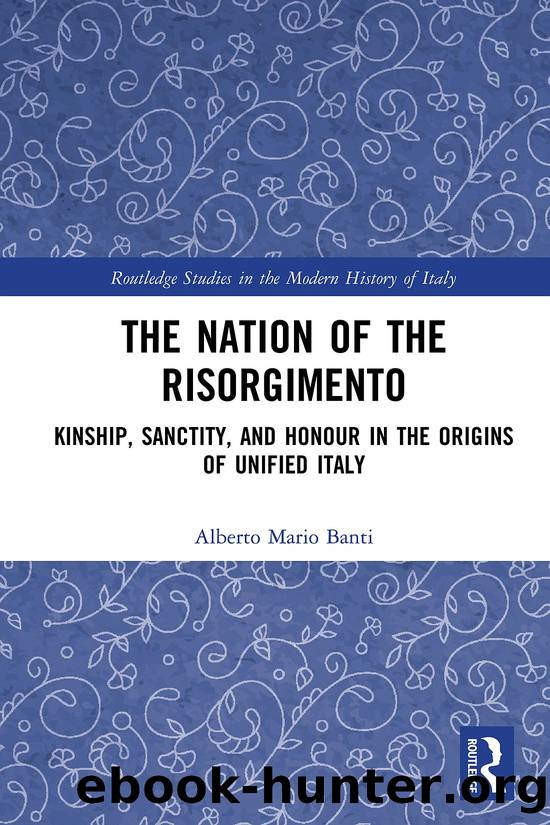The Nation of the Risorgimento by Alberto Mario Banti

Author:Alberto Mario Banti
Language: eng
Format: epub, azw3
ISBN: 9781000057454
Publisher: Taylor and Francis
2.
In the description within the works of the âcanonâ, as we have seen, the nation appears with the characteristics of an ethnic community that is endowed, from time immemorial, with biological and cultural features shared by all its members. This is to say that the nation is presented in the guise of an objective reality that from time to time is brought to life by the will of God, nature, or history. These causal factors might not all be evident at the same time within the same textual context, but they all contribute to the idea that people belong to this group by ascription, rather than by choice.
The development of this idea surely owes a great deal to the rediscovery of the thinking of Giambattista Vico, whose works became virtually required reading within the learned and lettered circles of the period between 1810 and the 1840s. Of particular interest, for us, is that the prominent promoters of Vicoâs early eighteenth-century reintroduction included one of the authors of works included in the canon, Vincenzo Cuoco, and that among the readers who became interested in the works of the Neapolitan philosopher, which were reissued in numerous editions in different parts of Italy during this period, were Foscolo, Manzoni, Berchet, Tommaseo, and Gioberti, who had been steered towards Vico by Cuoco, either personally or through his publications.7
Cuocoâs work of mediation functioned on two main fronts. Firstly, he took up and elaborated on Vicoâs hypothesis of âage-old Italic wisdomâ: in Platone in Italia, in a fictional and pseudo-scientific form, he developed the idea of the Etruscan and Pelasgian (and therefore pre-Roman) origins of the Italian nation. As discussed in Chapter 2, this idea was taken up and variously treated in learned works by other authors, and in particular underwrote the historical and conceptual construction of the âmoral and civil primacy of the Italiansâ put forward by Gioberti.8
In theory, we might think, the debate on myths of origin should be important in the development of the profile of a national community. In the Italian case, however, this aspect did not in fact generate symbols or images that were able to establish themselves convincingly within national and patriotic mythography. As we saw in Chapter 2, the symbolic imagery with the greatest effect and importance was drawn from the history of the Italian peninsula between late antiquity and the modern era, without the theme of the supposed Etruscan and Pelasgian origins of the Italian nation undergoing any elaboration, either narrative or iconographic. This should not be a surprise. The paleo-Italic and pre-Roman mythography would have seemed too unfamiliar to the reading public, the historical context too distant, and the portraits of its protagonists too indistinct. This is illustrated by Sismondiâs spontaneous observations on his reading of Giuseppe Micaliâs Italia avanti il dominio deâ Romani (Italy before Roman rule), in a letter to the Countess of Albany dated 19 November 1810:
I confess that reading this work gives no real satisfaction: it takes you fruitlessly and continuously around Rome, without ever helping you to enter.
Download
The Nation of the Risorgimento by Alberto Mario Banti.azw3
This site does not store any files on its server. We only index and link to content provided by other sites. Please contact the content providers to delete copyright contents if any and email us, we'll remove relevant links or contents immediately.
| Africa | Americas |
| Arctic & Antarctica | Asia |
| Australia & Oceania | Europe |
| Middle East | Russia |
| United States | World |
| Ancient Civilizations | Military |
| Historical Study & Educational Resources |
Magic and Divination in Early Islam by Emilie Savage-Smith;(1500)
Ambition and Desire: The Dangerous Life of Josephine Bonaparte by Kate Williams(1346)
Bohemians, Bootleggers, Flappers, and Swells: The Best of Early Vanity Fair by Bohemians Bootleggers Flappers & Swells- The Best of Early Vanity Fair (epub)(1344)
Papillon by Henry Charrière(1310)
Twelve Caesars by Mary Beard(1258)
Operation Vengeance: The Astonishing Aerial Ambush That Changed World War II by Dan Hampton(1137)
What Really Happened: The Death of Hitler by Robert J. Hutchinson(1131)
London in the Twentieth Century by Jerry White(1114)
Time of the Magicians by Wolfram Eilenberger(1089)
The Japanese by Christopher Harding(1086)
Twilight of the Gods by Ian W. Toll(1084)
Lenin: A Biography by Robert Service(1045)
The Devil You Know by Charles M. Blow(985)
A Social History of the Media by Peter Burke & Peter Burke(938)
Freemasons for Dummies by Hodapp Christopher;(923)
Napolean Hill Collection by Napoleon Hill(903)
Henry III by David Carpenter;(892)
The Churchill Complex by Ian Buruma(884)
The Rise and Triumph of the Modern Self by Unknown(880)
